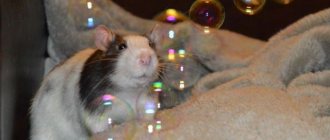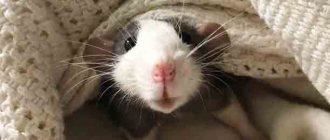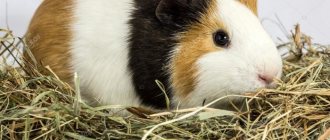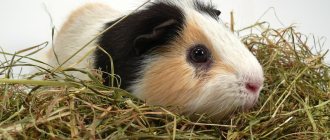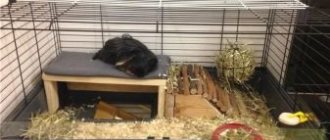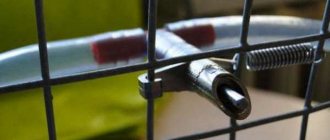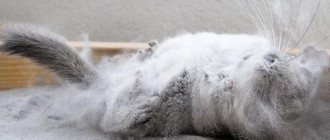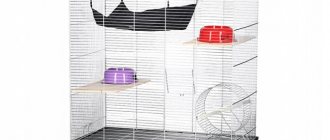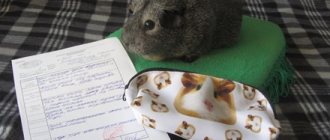Guinea pigs are playful and sociable creatures. In the absence of the owner, they can get bored. Therefore, it is worth placing toys in your guinea pig's cage so that he can have fun on his own. Toys make a pet's life more fun and help him get used to a new environment faster. In addition, regular exercise is beneficial for your pet's health.
Keeping and caring for a guinea pig
A guinea pig is a sociable and unpretentious pet, the maintenance of which does not require much hassle and significant expenses.
Guinea pigs are very friendly. They can show aggression or withdraw from contact only if the previous owner offended them, took poor care of them, and also if the pig was hurt or feels unwell. In all other cases, they communicate with pleasure, love to sit in your arms and play. Guinea pigs are intelligent, curious, and easy to train, so you can teach your furry baby to respond to his name, follow commands, stand on his hind legs, or give his paw in greeting. If you exercise with your pet for 10-20 minutes every day, then in a couple of months you will be able to entertain your loved ones and guests with amazing tricks.
The animals are very clean, they spend a lot of time caring for their fur and paws, and if you have several pets, they will help each other look beautiful. Stories that pigs have an unpleasant odor are completely unfounded. If the animals are kept clean and the owner changes the bedding twice a week, there will be no smell.
Another undoubted advantage of guinea pigs over other pets is hypoallergenicity. Pig fur does not provoke allergies, like the fur and fluff of other pets.
Keeping a guinea pig does not require much hassle or expense. Hay and hygienic cage bedding are inexpensive. The stores offer a wide selection of grain mixtures and treats to suit any budget. In addition to hay and grain, the menu should include fresh fruits, vegetables and herbs, and only seasonal ones. Giving exotic foods, for example, pineapples, mangoes, kiwis, as well as greenhouse vegetables: cucumbers and zucchini, is strictly not recommended in winter. In the summer, it is advisable to supplement the rodent's menu with fresh grass collected in a clean place. And guinea pigs just love parsley!
You shouldn't walk outside with your pig. Firstly, it is very stressful for the animal. Secondly, he can be injured by other pets, cats or dogs. Thirdly, a pet can “catch” an infection or parasites in the grass. However, it is very healthy for pigs to be active. What to do? Let him out of the cage to walk around the room for 30-40 minutes. But definitely under supervision. After all, this animal is a rodent, and wires, furniture legs, wallpaper, sofa upholstery can make her want to sharpen her teeth.
Guinea pigs do not require special care at home. You need to feed the animals 2-3 times a day and make sure that the water in the drinking bowl is clean and not stagnant. The bedding needs to be changed twice a week; cleaning the cage takes 10-15 minutes. As you can see, there are no special requirements. There is only one case where a pig will need daily care - if it has long fluffy hair.
The pet needs a small cage, with a base of approximately 40x70 cm, provided that the pig walks around the house every day. This compact cage is easy to install even in a small room. The height of the cage does not matter, since guinea pigs are not as fond of climbing ladders and labyrinths as rats or hamsters. A single-tier low cage with a house or other shelter is enough for them, where they can hide from noise and relax.
With proper nutrition and good care, the animal will delight you for 7-10 years. Guinea pigs, if well cared for, enjoy good health. Proper nutrition, hygiene and absence of drafts are the key to your pet’s health. This adorable rodent is the perfect pet for a child. Cute and friendly pigs quickly find a common language with their little owners and will give a lot of positive emotions. And children, taking care of an animal, become more responsible, attentive, and disciplined.
Team training
After taming, they begin to train guinea pigs
It is important to remember that you should not shout at your pet or use force against it.
You should not try to master all the tricks in one training session. It is better to start with simple commands, and after successfully mastering them, move on to more complex options.
The tasty reward should be removed gradually and only after the command has been fully mastered.
Stand
The simplest command for any animal. To teach this command to a guinea pig, you need to place the animal on a flat, hard surface. A treat is held over the pet's head. The animal reaches for the treat, at which time the owner calmly says “stop.” The animal can reach the treat by standing on its hind legs. When this happens, the animal is praised and treated. The command must be repeated several times and the pet must be treated. These actions need to be repeated until the animal understands what is required of it. After mastering the command, it is repeated periodically so that the pet does not forget.
To me
This team will need about two weeks to train. To begin with, the rodent is placed on a flat surface a meter from the owner. Then the owner shows the pig a treat and calls him by name in a calm voice. As soon as the animal approaches, you need to pet it and treat it with a treat. It is better to do classes every day. After mastering the command, the distance between the student and the teacher is increased.
U-turn
To execute this command, you need to bring the treat over your pet's head. When the pig becomes interested in the treat, you need to slowly begin to describe a circle above the animal’s head. It is better to move your hand clockwise, while repeating the command “circle” or “turn around”. You should not immediately make a circle if the animal quickly loses interest in the treat. You can first make turns of 45 degrees, then 90 and until the turn is complete. You need to train every day so that the animal does not forget the learned elements.
Kiss
It doesn't take much effort or training to execute this command. All you need to do is hold a piece of the animal’s favorite treat with your lips. Then you need to bring the pig to the owner's head. As soon as the pet smells the tasty treat, it will reach out to its owner’s lips and take a piece.
Give me your paw
This command is more difficult to execute than the previous ones. To do this, you need to put the pig on the sofa. The owner himself is located in front of the rodent on the floor. He extends his left hand, palm up, towards the animal, and with his right hand he lures the animal with a treat. When the animal begins to move towards the person, the owner gives the command “give me your paw.” And as soon as the student’s paw is in his hand, the animal is praised and treated to something tasty.
It is important to be careful so that the animal does not fall on the floor
Achieving results in executing this command requires regular training.
Roll the ball
This command is also based on the guinea pig's natural desire to eat. To execute the command you need a ping pong ball or other small light ball, a strip of carrot or celery. Place the treat under the ball and wait for the pet to become interested in it. And then you can give the command “Push.” To get the treat, the pig will have to push the ball with its muzzle. This team needs to be trained regularly to achieve results. After a few sessions, the bait is removed from under the ball.
Jump through the ring
This command will require a ring and a treat. You can make the ring yourself from wire or use a tennis racket after removing the fishing line.
First, the ring is placed edge-on on the floor. A pig is placed on one side of the ring, and a treat on the other. Having noticed the treat, the pet will go to it through the ring. At the same time, the owner gives the command “ring”. If your pet doesn’t see the treat, you need to move it closer.
As soon as the pig gets through the ring, he should be praised and allowed to treat himself. Over time, the ring is raised. The final lifting height of the ring is considered to be a distance of 3 cm.
Trained guinea pigs are not exotic, but a completely normal phenomenon. Each owner can teach the animal to follow commands in order to develop it and entertain it. And the owner will also have a pleasant time with his pet.
What should be in the cage
The minimum acceptable cage size for this rodent is 40x70 cm. The pet must have space to walk, and the larger the cage, the better. Do not forget that accessories will also occupy a certain place in the home: drinking bowl, feeders, house.
The best drinker option is a ball bowl. It does not create dampness in the cage, saves space, keeps the water clean - pieces of food and excrement do not get into it. However, you need to take care of the drinking bowl - change the water in it daily and wash it thoroughly so that plaque does not appear on the walls. The drinking straw should also be cleaned regularly with a cotton swab.
Drinking bowls are less practical: the water from them spills, the animal can wet its paws and tummy, and if the house is cool, then an unplanned bath can lead to a cold. The water in the bowl gets dirty quickly, so you will have to change it several times a day. The bowl also takes up quite a lot of space in the cage. However, it is easier to wash a bowl than a drinking bowl, and your pet will not make any noise while drinking.
Feeders for grain and succulent food should be different. There are plastic and ceramic models on sale, so you can buy the option that you like best. Plastic bowls come in a variety of shapes and colors, are made of safe material and are inexpensive. However, they are lightweight and guinea pigs tend to tip them over. Ceramic feeders are heavier and cannot be easily turned over. Clay bowls are versatile in design and durable.
Necessary accessories for a guinea pig cage include a house. Without shelter, the pet will feel uncomfortable, nervous, and perhaps even show aggression. Therefore, take care of a house or at least a canopy under which the guinea pig will hide, where he can set up a bed and feel comfortable.
To make your pet and you feel comfortable, you should purchase a hygienic litter. Granulated wood filler, both odorless and scented, and sawdust are available in stores. You can also use hay as filler in the cage. The filler needs to be changed 2 times a week. Another option is also possible: remove some of the soiled litter every day and add a handful of new litter - in this case, a complete replacement of the litter will be needed only once a week. This option is possible due to the neatness and cleanliness of the animals - they usually choose a certain place in the cage as a “toilet”, and cleaning this area takes 1-2 minutes.
Guinea pigs are indifferent to toys; an excellent entertainment for them can be a spikelet or a mineral on which they can sharpen their teeth. Pigs also like to create a space for themselves to rest and make a nest out of bedding or hay. You can offer the animal a small cloth napkin, and he will enthusiastically place it in the house as a sheet or pillow.
Fruit branches
Pigs who love to chew will appreciate thin branches in their home. Only they should be picked from your own garden or forest to avoid trees soaked in chemicals. The fruit is also important - apple branches are allowed to be given to the animal without pre-treatment, but plum, apricot, and cherry branches are strictly prohibited because they are poisonous.
You can create toys for guinea pigs with your own hands from almost anything, the main thing is to show your imagination. Then you will not only save on the purchase of expensive accessories, but also receive an original handmade item.
Rules for feeding guinea pigs
The basis of the guinea pigs' diet is grass and hay. There should be at least 60% of them in the daily menu. Grass is needed not only as a main source of nutrients and fiber. Rodents wear down constantly growing teeth on leaves and stems and maintain them in normal condition.
The remaining 40% of the diet is a grain mixture and succulent food in equal proportions. Grain supplies guinea pigs with natural proteins, carbohydrates, minerals, essential amino acids, and vegetables, fruits, berries and herbs are an excellent source of vitamins. Guinea pigs need more vitamin C than other rodents, so it is necessary to feed them with foods that contain large quantities of the vitamin: parsley, sweet peppers, celery, and if the pets don’t mind, then tangerines.
Spikelets, sticks and other snack treats complement the diet, make it more varied and help to wear down teeth, but they cannot be used as the main food.
Your pet should always have water, even if he doesn’t seem to drink it. Make sure that the water is clean and that the bottle does not turn green on the inside or acquire an unpleasant odor. Stale water can cause serious health problems for guinea pigs.
Veterinarians recommend feeding adult pigs twice a day, morning and evening. At the same time, uneaten succulent food and leftover hay should be removed so that mold does not grow on them. It is deadly for guinea pigs. Treatment of poisoning from spoiled foods does not always end successfully.
Upbringing
Raising a pig does not begin on the first day it arrives in the house. First, the animal is allowed to get comfortable, tamed, and then shown what is allowed to do in the house and what is strictly prohibited.
You need to tame the animal from the first days of life in the house. For this:
- Immediately after the rodent appears, it is placed in a cage, which is covered with dense material. This way, the pet will not be distracted by visual sensations, but will get used to the sounds and smells.
- At first, the owner should talk to the pet in as calm and gentle a voice as possible.
- After some time, you can offer the animal a treat from your hands.
- After a week, the dense material is replaced with a lighter and more transparent one.
- After another week, the cape on the cage is removed. After this, the owner must leave the room so that the pet can look around.
After taming, you can and should begin raising your pet.
The first thing you need to pay attention to is safety. This applies to both pet and owner
Rodents need to wear down their teeth, so they can chew on any objects they like. This could be furniture, wires, small things left in its path. To prevent property damage you need to:
- Monitor your pet's behavior when the animal is on a walk.
- Place the cage in a space free of foreign objects. That is, there should be no things near the cage that the rodent could reach.
- Close the cage carefully to prevent the pig from escaping.
If an animal constantly gnaws on an object while walking, it is recommended to apply a special gel or solution to the favorite item. This product has a bitter taste, but at the same time is absolutely harmless to animals. To wean yourself from damaging things, you need to apply the product regularly.
Grooming: brushing
Short-haired guinea pigs do not need special care for their fur; they do an excellent job on their own. If you want to give your pet pleasure, you can pet him once a week with a soft, short-bristled brush. The pig will probably like this massage, and at the same time you will comb the fur and remove some dead hairs. Pigs without hair will not need a brush at all, but with long-haired pets you will have to tinker. Guinea pigs with wavy hair require special attention, since one straw or blade of grass is enough to create a tangle.
The long-haired animal requires your daily attention - 10-15 minutes. First, the fur needs to be combed with a sparse comb, removing specks and untangling tangles with your hands. Then you should comb the coat with a thick comb and finally go through it with a brush so that the coat becomes shiny and lays down as desired.
If you comb it daily, it will not cause any particular difficulties, but if you comb the animal less often, it will be a longer and more labor-intensive process. And it’s also unpleasant for your pet, because when combing matted fur, he experiences pain, and the tangles not only spoil the appearance, but also cause discomfort: the skin under them begins to swell and become inflamed. If the tangle cannot be sorted out, you need to use scissors and carefully cut it out.
Grooming: Bathing
Clean and tidy animals with proper care and regular cleaning of the cage do not need frequent bathing. Veterinarians recommend bathing pigs 1-2 times a year. But if your pet gets dirty in any way, bathe as needed. Use special shampoos for spa treatments - you can buy one bottle and it will last for several years. For show animals, you will also need a conditioner or balm, which will make the fur silkier and shiny.
You need to bathe your pig carefully so that water does not get into the eyes, ears and nose. The animal should be lowered into a container of warm water so that the head and upper back are not submerged in the water. Then wet the fur with water and apply shampoo, rub it over the fur with smooth movements so that the fur does not tangle, and then use a sponge to carefully rinse off the shampoo. The product must be washed off thoroughly, otherwise your pet may develop dermatitis and other skin diseases.
After bathing, quickly dry the animal with a towel, comb it a little with a sparse comb and then dry it thoroughly with a hairdryer so that the hair does not become tangled during the drying process. Short-haired pigs can then be brushed with a soft brush. For long-haired dogs, the standard combing procedure is performed: with a sparse comb, then with a thick comb and a brush. After bathing, make sure that your pet is not exposed to cold or drafts - guinea pigs catch colds easily.
Walking outside and at home
Outdoor walks are organized subject to the following conditions:
- Choose a secluded place where there are no animals or people.
- Enclose the play area using an aviary or other devices. Or use a harness and leash.
- Go out only in warm, dry weather. If during the morning walk the dew has not yet left the grass, blot it with a paper towel.
While on the street, the pig requires constant supervision because it is in a high-risk area. Before leaving the house, you should apply an anti-parasite spray to the fur so that the animal does not bring ticks or fleas from the street.
The walk lasts about an hour or until the animal shows signs of fatigue: it reduces activity, stops playing, or sits motionless.
How to take care of your teeth
Guinea pigs, like other rodents, have incisors that grow throughout their lives, and to prevent them from causing health problems and injuries, they must be constantly ground down. Usually pets do an excellent job of this task without outside help. You only need to provide the animal with everything it needs: hay, grass, hard vegetables, delicacies-spikelets on a solid base. There must be chalk or mineral stone in the rodent's cage. It is needed not only for grinding teeth, but is also a source of calcium, a microelement necessary for strong bones and teeth, and good health in general.
You can also offer the rodent branches of fruit trees, peeled from the bark: apple trees, apricots, pears, etc. For many pets, gnawing on sticks is also an exciting pastime.
If you give your guinea pig only soft food, its teeth will begin to grow rapidly and will interfere with eating and hygiene. If this happens, contact the clinic. Veterinarians will trim your pet's teeth to the desired length and tell you how to avoid this problem in the future.
Reproduction
The female is ready to reproduce offspring already at the 5th month from birth, the male guinea pig at the 6th. But breeders recommend that the first matings be carried out no earlier than the pets are 10 months old. Animals of the same breed and age that are not related to each other are chosen as parents. Obese individuals are not suitable for reproduction.
Females are ready to breed every two weeks or month for two days. 10 days before the onset of estrus, vitamin E is added to the female’s diet. It is best if the female becomes pregnant no later than November, then she will have time to feed her offspring before the onset of molting. Molting is a difficult process for an animal; in combination with feeding, it puts a lot of stress on the female’s body.
It is easy to determine that a female is ready to mate. She lifts the back of her body, spreading her paws to the side.
Fertilization occurred if the female did not start another estrus within 20 days. Then she is transplanted into a separate cage.
The female's pregnancy lasts 10 weeks. At this time, you don’t need to carry her in your arms, often take her out of the cage and fiddle with her unnecessarily. Excess stress can lead to miscarriage.
Mother pigs can develop toxicosis. It occurs in the period before and immediately after childbirth. At this time, females experience muscle cramps, loss of appetite, deterioration of coat condition, and drooling. Toxicosis can be avoided if you make the right diet, add vitamins and prevent stress. Toxicosis also occurs due to pregnancy with many children. Females usually give birth to 3 to 5 piglets.
Guinea pigs usually give birth as usual and last about half an hour. Newborns can see and hear and also have incisors. 2 days after birth, they can already eat regular food. And when they are a month old, they can be moved into a cage for further independent life.
Before getting a guinea pig, study information about these cute rodents. Caring for the animals will be easy for novice breeders. However, the owner is responsible for the health and well-being of his pet. After all, only a healthy animal will be cheerful and playful and bring joy to its owner.
Claw care
Claws on the paws do not grow quickly, but eventually reach an unaesthetic length and begin to interfere with the pet’s hygiene. On the front paws, overgrown nails curl up and interfere with walking, causing deformation of the toes. This is why your guinea pig’s claws need to be trimmed a couple of times a year. To do this, you will need special tweezers or the smallest nail clippers, as well as a regular nail file.
The claw must be trimmed so as not to touch the blood vessels, otherwise severe bleeding will begin and the animal will experience unbearable pain. Nail trimming should be done carefully and without haste. The cut should be made strictly perpendicular to the growth line so that they do not delaminate during the pruning process.
